
The Best Lasers for Hair Removal
When tackling body hair, you want to find a laser that will get as close as possible to permanent hair removal. Top picks will vary based on your skin tone, targeted area, and your budget.
Read on for everything you need to know to figure out which is best for your body hair goals.
We even included the unsung hero of the bunch, at-home IPL treatments — just in case you love tackling fuzz in a more relaxed environment.
Table of Contents
Does laser hair removal get rid of hair permanently?
Treatment Timeline: How long will it take to be hair free?
How Laser Hair Removal Works
Laser hair removal works by targeting the pigment, or melanin, at the hair follicle with heated light energy. The damage from those laser pulses to the follicles inhibits growth over time, permanently reducing unwanted hair in targeted areas.
What does the word LASER stand for? The word LASER stands for Light Amplification by Stimulated Emission of Radiation.
Scientists came up with the acronym in the 1950s, likely because the long version is ridiculous.
When it comes to hair removal, IPL and laser work in similar ways.
What is the difference between laser hair removal and IPL? The difference between laser hair removal and IPL is in the method of hair removal. IPL hair removal systems use broadband pulsed light instead of a single focused laser.
The results are the same: Permanent reduction of hair wherever you’d like it to stop growing.
Does laser hair removal get rid of hair permanently?
Laser hair removal does get rid of hair permanently. You may need touch ups every 3-6 months for sparse regrowth, but most enjoy up to 80% permanent hair reduction and removal once they’re done with their initial course of treatment.
You can expect the same results from at-home IPL treatments, with just a few extra sessions. It’s worth it when you realize you don’t need to leave your couch, kitchen, etc. for your sessions. You just need to make a date with yourself and get it done.
Treatment Timeline: How long will it take to be hair free?
The number of sessions you’ll need to get those underarms, upper lips, and bums hair-free depends on a few factors. The areas of the body you target matter. Your hormones matter. How keen you are on keeping your appointments is important, too.
In most cases, you’ll need 4-6 laser hair removal treatments with maintenance touch ups to follow. It pays to be patient. As time goes on, hair grows in sparser and finer. By the end of treatments, you could enjoy months, even years without a treatment.
IPL hair removal devices require a little more of that patience, but they’re just as effective as laser hair removal for permanent body hair reduction and handling hair growth.
Expect to set aside time for twice-weekly sessions for about 6-8 weeks to start your new IPL habit. Touch ups after that point are easier to fit into your schedule.
Types of Hair Removal Lasers
How many types of laser are there for hair removal? There are 4 different types of laser out there for hair removal: ruby, alexandrite, diode, and Nd:YAG lasers.
IPL is often listed as the fifth type, but we don’t include it in that count because it’s not technically a laser. To confuse you further, some dermatologists and other providers use a combination of lasers depending on your hair type, skin types, and the targeted area.
IPL (Intense Pulsed Light)
IPL is a gentler approach to hair removal. If you’re worried about discomfort with laser, electrolysis, or waxing, IPL could be the answer to a swimsuit season with less ouch. Honestly, you may not even feel a tickle with IPL, but it’s easier to monitor pulse duration with a DIY device.
View this post on Instagram
It’s also easier to handle larger areas with an IPL device thanks to its larger spot size. That just means the spectrum of light covers more ground than a single laser.
It’s not for everyone, though. IPL works best when there’s an obvious contrast between your hair and your skin. Otherwise, the device has a hard time finding follicles to target for hair reduction. Light skin and dark hair is the ideal combo for IPL.
Ruby Hair Removal Laser
The ruby laser gets its name from the synthetic red crystal used as its light source. It has the shortest wavelengths, so it’s really only good for that classic ideal contrast of light skin with dark hair.
This one was the first functional laser out there, but it isn’t as easy to find as the others we’ll get into next. The results just aren’t as impressive and risks of side effects are higher with its slow repetition rate.
Alexandrite Hair Removal Laser
The alexandrite laser is a near-infrared laser built for speed. This is the fastest option with a larger spot size than the other lasers, so it’s a favorite for larger areas like your legs or back.
That speed can come with more discomfort than some of the others, but everyone doesn’t feel laser hair removal the same way. It can depend on the treatment area. E.g., your underarms will likely feel laser treatments more intensely than your forearms.
If you’re a delicate flower, ask your dermatology clinic for topical creams to numb you up before your treatments.
The wavelength on this one is longer than the ruby, but shorter than all of the others. That makes it a good option for light, medium, or olive skin tones.
Diode Hair Removal Laser
Diode lasers are the most versatile option. They’re great for small areas like facial hair and larger areas like a full back. They work well with light skin and darker skin. That’s all thanks to varied wavelengths.
When used appropriately, they offer some of the most impressive long-term results for coarse hair, fine hair, and a variety of hair colors.
That said, you really need a provider who knows their stuff if this is your pick for laser hair removal. The wrong wavelength puts you at risk for scarring and hyperpigmentation.
Nd:YAG Hair Removal Laser
The Nd:YAG laser has the longest wavelengths of all the available lasers. That means the infrared laser can get beyond the top layer of dark skin to the hair follicles where it belongs. Experts say it works for tanned skin, too.
We’re not telling you to go on that beach vacation before your laser treatments, though. It’s always best to avoid too much sun exposure or risk changing the pigment of your skin. If you need a sunscreen rec, try The Glow Up, an SPF 30 with a side of moisturization.
Back on topic, the Nd:YAG is not as effective on fair skin and very fine hair. It’s also not as powerful as the diode, but studies show fewer side effects than some of the surface-level lasers because it goes below that top layer.
Risks and Benefits of Hair Removal Lasers
Serious side effects like scarring or blistering are rare with laser hair removal. Temporary skin irritation and redness are more common but temporary. Sensitive skin types can use cold compresses, ice packs, or a soothing gel like The Reviverpost-treatment to chill out their skin.
Hyperpigmentation is more common with darker skin tones, but less common when you’re set up with the right device. We’ve said it already, but longer wavelengths are the best laser technology for darker skin colors.
Expertise is important, too. You want a provider who knows what they’re doing, no matter your skin color, but it’s especially important when you’re worried about lasting damage.
Practice solid skincare between treatments. Exfoliate to smooth skin and speed up hair loss and shedding, using a product like The Revealer. Avoid plucking, picking, or scratching at the treatment areas to reduce irritation.
What’s right for you?
Deciding on the best laser for you is like deciding what to wear at any give moment. If you’ve planned a Netflix and chill situation, that will look different than brunch with grandma. If it doesn’t, more power to you. Here’s the skinny:
- If you find a good deal on a round with a ruby laser, it may work fine for small areas. We’d recommend a patch test before you commit, though.
- If you have a need for speed and have a higher tolerance for discomfort, the alexandrite laser is the fastest option.
- For those who just aren’t sure where to start, the diode will likely work no matter what you’re working with, when it comes to your hair and your skin.
- Darker skin types should seek out the Nd:YAG laser as their top option and diode lasers with longer wavelengths as a decent second choice.
- If you’re a DIYer and your bikini area needs some work, at-home IPL should do the trick.
Time To Get Nood
At Nood, we took the good things about laser hair removal and ran with them. IPL is more cost effective and just as good at permanent hair removal as traditional lasers.
Ready to get your Nood on? Try The Flasher 2.0 and our 90-day money-back guarantee today. Need some social proof? Check out our Instagram.

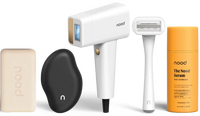


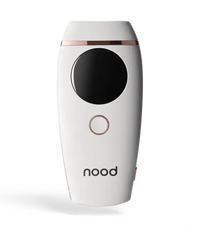
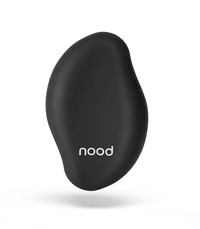
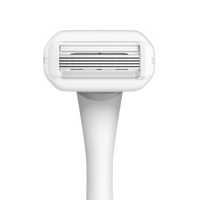

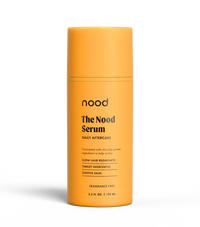
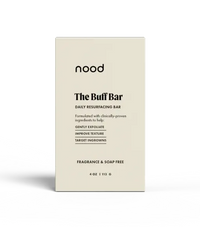
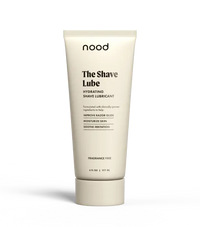


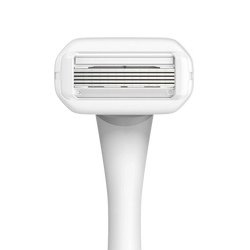
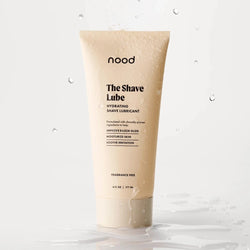

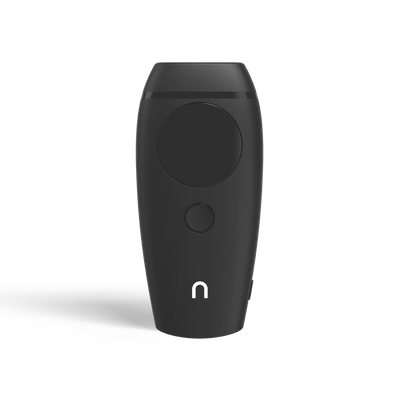
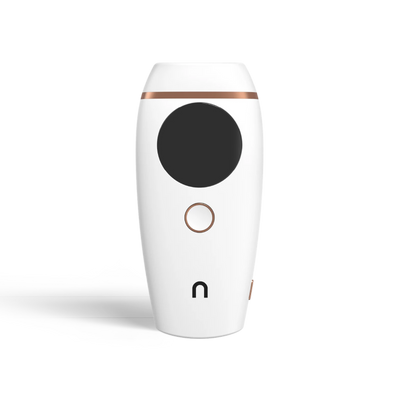


![14 Expert Tips For Laser Hair Removal [Including What NOT To Do!]](https://dropinblog.net/cdn-cgi/image/fit=scale-down,width=700/34248500/files/featured/Tips_For_Laser_Hair_Removal.jpg)

